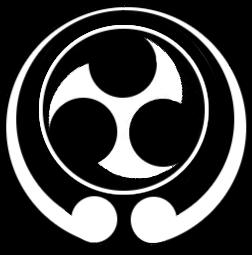
![]()
![]()
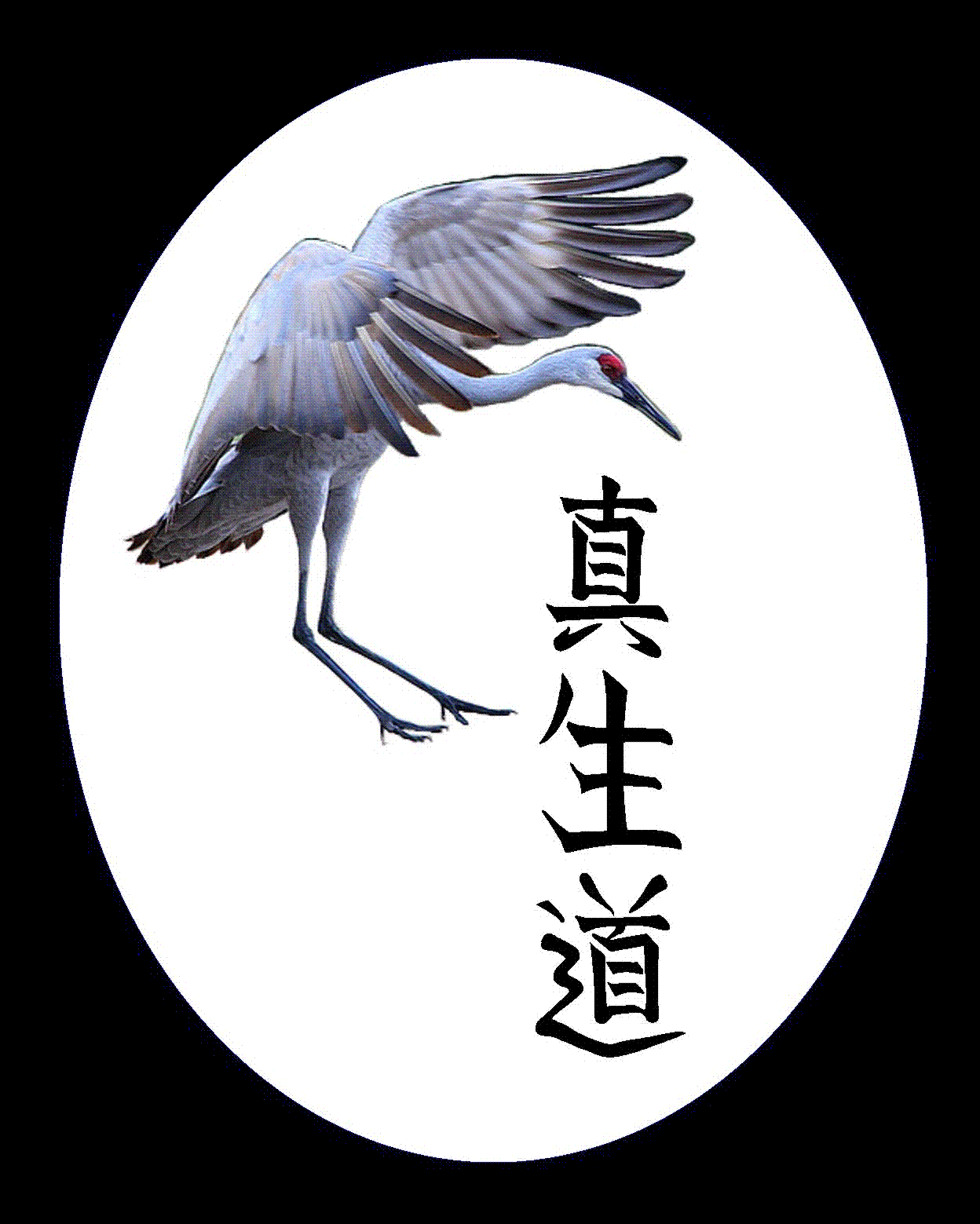
Headingley Karate
|
|
|
Leeds Instructors
Mike is assisted in teaching by his long term students and colleagues:
- Carl Evans
- Martin Lewis
Mike in his own words (written sometime around 2010) ...
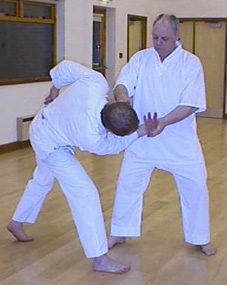
Mike being educated by his Shinseido teacher, Roger Sheldon
|
Training History
I first started training in Karate as a child in 1977 under Walter Seaton, then 4th dan in Wado Ryu. Walter Seaton was quite an inspirational instructor, but at the time I didn't appreciate what a good quality club I'd joined - I just assumed all Karate clubs had a dozen or so skilled black belts attending each session. Frankly however I was an indifferent student. I trained sporadically for several years, until the point where I'd had so many absences I didn't dare go back! Instead, in 1982 I started training in Taekwondo under my schoolfriend Mike Winship and his instructor Dick Pallister, 5th dan in WTF Taekwondo. I was never very good at the spinny- kicky Taekwondo stuff, but if nothing else I learned how to spot and thwart such flashy techniques.
I started university in Leeds in 1984 and tried Shotokan Karate under Bob Rhodes (I think 4th dan) and also ITF Taekwondo with Kim Stones (2nd dan). Bob Rhodes was stern and unapproachable to say the least, but Kim was much friendlier. He was known as the 'golden boy of Taekwondo' due to his dashing looks and competition success. Neither style really appealed to me though. I was looking for something different, but I didn't know what. I trained for a little while in Kodokan Ju-jitsu under Peter Clark (then 3rd dan), but unfortunately couldn't continue that for long as it clashed with my next training opportunity - security/door work.
In 1986 I took a year out from university and started working part-time as a bouncer/doorman for music events, initially at the university student union but later at a number of other venues too. I quickly realised a couple of important points that have stayed with me through all my martial training since that time:
- Body language and conflict resolution skills are more important in self-defence than actual 'fighting' skill,
- The striking arts I'd practiced were sorely lacking when it came to dealing with real violence.
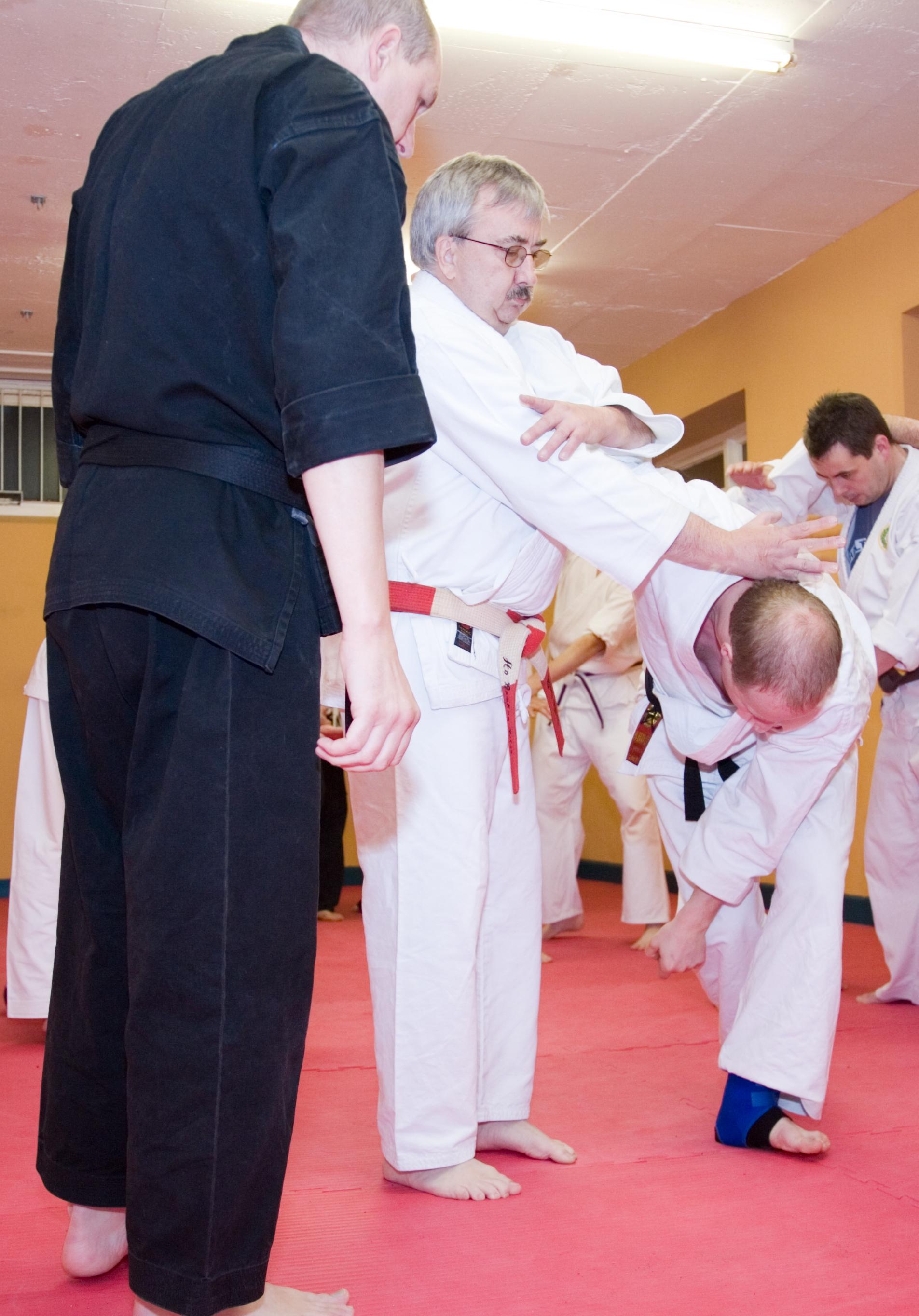
Ouch, this time its Rick Clark (as Mike Sanderson of Hull Kenkyu Kai looks on and sniggers)
|
I gave up regular security work in 1989, only coming 'out of retirement' for occasional special events. The same year I also suffered a knee dislocation, an exacerbation of an old injury that had come back to haunt me. As a result of this injury I gave up any thought of returning to martial art training. It was clear that my knee could not cope with any of the arts I'd previously practiced. It was also clear that, although martial art training hadn't caused the injury, it had certainly made it worse.
I knew I couldn't train, but during the early 1990s I maintained an interest and read about Karate and other arts, which was how I came to hear about the work of the American George Dillman, who was forging a reputation for himself due to his reported skills in Kyusho-Jutsu and Bunkai. Since that time George Dillman has been - quite rightly - much criticised and even ridiculed. But at the time the ideas he was putting forward were nothing short of revolutionary. From reading his work and other available research on the history of Karate, and comparing with my own real life experiences, several important points became apparent to me:
- Karate, as I had learned it, was not the same art as Karate in the past (ie. the 19th century).
- Karate, as I had learned it, was not really designed for self-defence, which was why I'd had such difficulty adapting it for use as a bouncer.
- The Karate of the past did not rely on deep stances or high kicks.
- As a result of this, it might be possible that I had could train seriously in an old style of Karate, without causing more damage to my knee.
- Despite many superficial similarities with modern Karate, the old Karate techniques were very different from their modern counterparts, and put much emphasis on attacking vital points.
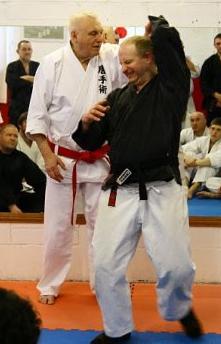
Ouch again, this time courtesy of Terry Wingrove
|
In early 1996 I attended a seminar with Vince Morris in Nottingham. Vince was a 5th dan in Shotokan at the time, although even then his Karate had travelled a long, long way from its Shotokan roots. Many have described Vince's seminars as eye-opening, I was no exception! His understanding of kata, his pragmatism and his dynamism were exceptional. I have still yet to meet anyone else who can move as dynamically and powerfully as Vince. Naturally I attended the sessions at Cyril's Gym in Nottingham as often as I could.
However, I still yearned to get closer to the old Okinawan tradition, and to the old ways of practising kata. This wasn't just a romantic ideal to me. It was the logical next step for two reasons:
- If you want to truly understand the meaning of the kata it makes sense to study the oldest versions you can, so as to see past all the changes that were made after Karate changed from a 'jutsu' to a 'do' art.
- Given my knee problem, I had no choice but to pursue an art that involved tall stances and low kicks (rather than deep stances and high kicks).
My first choice of teacher to investigate was Roger Sheldon in Sevenoaks, on the basis that he was teaching Shorin Ryu, the very system that was the ancestor of the modern styles I'd studied. As it turned out, I knew immediately on meeting and training with Roger that I had made the right choice. His research into historical Shorin Ryu and its kata was impressive, and certainly without equal in Britain. I was lucky enough to have found on an excellent teacher, mentor and - as time went on - great friend.
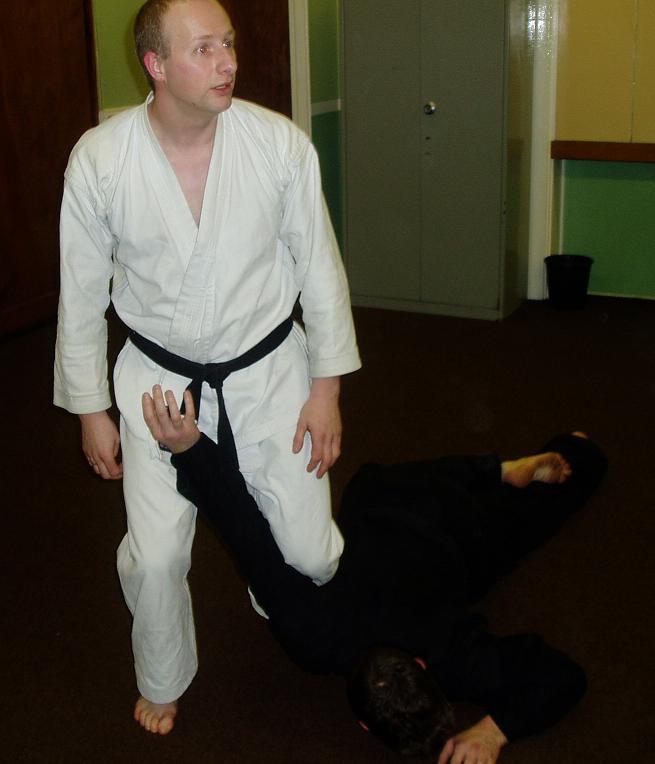
Mike demsontrating a joint-lock using only the legs
|
Shiatsu proved to be an excellent complement to martial art training. Each benefits the other. Most especially, I found that the Shiatsu method of using relaxed bodyweight to generate force had a tremendously beneficial effect on my Karate. It was also a great opportunity to further my understanding of Qi Gong, under my main Shiatsu teachers (Chris Osbourne and Graham Crisp), and under their various guest teachers (most memorably Daverick Leggett).
Between studying Shiatsu and Karate time passed quickly! On the odd occasion that I had some free time, I also managed to get in a few lessons of Aikido with Rob MacFarland (a fellow Shiatsu practitioner) at the Ki Aikido school in Brighton.
As 1999 drew to a close my efforts were rewarded when I both qualified as a Shiatsu practitioner and was awarded 1st dan (black belt) by my primary teacher, Roger Sheldon. It felt like I'd arrived! Of course, I was only too well aware that - contrary to popular belief - grading to black belt does not imply mastery. Its more like passing your driving test: you're allowed out on the road, but you've still got much to learn.
In 2000 I moved back to Leeds with the aim of setting up my own Shiatsu business. Although this took me away from regular training with my Shinseido colleagues it did at least mean I was able to train with Vince Morris in Nottingham more frequently again. The same year I was awarded 1st dan in Ao Denkou Jitsu by Rick Clark while at the 'ADK 2000' 3 day seminar in Edinburgh. In the same year I trained for a few months in Atemi Ju-Jitsu under Dan Buckley (6th dan?), but unfortunately had to stop after badly spraining my ankle due to an improperly executed breakfall.
I began teaching Shinseido in 2001 and have taught at the same venue in Headingley since then. I have endeavoured to maintain my connection with my Shinseido teacher, Roger Sheldon, and my old colleagues at the main Shinseido club in Sevenoaks. I've also taken up other good training opportunities where they've presented themselves. I had some experience of Mike Finn's Tanjo stick system with Eva Bayerlein in Nottingham. For a while I was able to attend regular seminars in Kaze Arashi Ryu Aiki-Ju-Jutsu in Burnley, organised by the then UK chief instructor, Kirby Watson. I've also studied a little more Tai Chi, this time learning the Cheng Man Ching form with Colin Hamilton of the Yiheyuan group in Leeds. More recently (from 2006?) I've had the opportunity to train with Terry Wingrove (9th dan Ju-jutsu, 8th dan Karate) a number of times. After my first session with Terry I was hooked - it was the most painful martial art lesson I'd ever experienced! Through these sessions I've also been introduced to and trained with Alan Ruddock (a direct student of Morihei Ueshiba, the founder of Aikido) and, even more recently, Tino Ceberano (9th dan in Goju Kai Karate). I hope to be able to spend more time training with these instructors over the next few years.
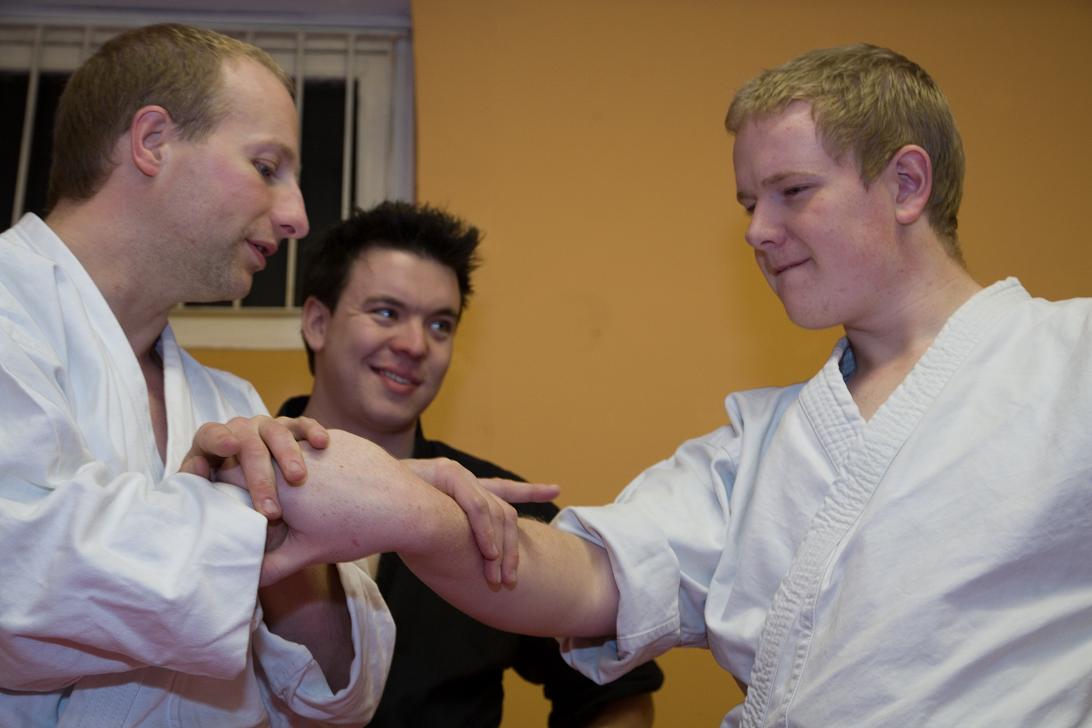
Working on the finer points of the nikyo wrist-lock with students at a seminar in Hull
|
Some Random Thoughts on Training
Enjoy yourself
First and foremost, I think you should enjoy martial art training. I've met too many martial artists who take themselves far too seriously, thinking that being a black belt involves glowering and frowning a lot. It doesn't! It takes a lot of time and effort to achieve a high level of skill, if you don't enjoy the process then you might as well stop. That's not to say that the training shouldn't be challenging or difficult at times, quite the contrary. Only by challenging yourself can you reap the maximum benefits and enjoyment that martial art training has to offer.Anyone should be able to train
I believe that almost everyone can practice a martial art. Regardless of whatever injury or health problem you have I think you should be able to train in some way or other, and to improve your skill in terms of self-defence (I'm living proof of this myself). You may never be fit, strong or well enough to enter the 'Ultimate Fighting Challenge' but that's not really the point. You can still use martial arts as a vehicle for your own self-improvement, and get better at defending yourself. But you do have to train in the right way. Many people end up quitting martial arts because they don't listen to the warning signals from their own bodies. Instead of trying to work around their limitations they try to push through them, often with unfortunate yet predictable results. I've found it's far preferable to take a two pronged approach: a) work around the limitation, b) at the same work gradually to remove or reduce the limitation. Over time you'll find that you can probably reduce the effect of your limitation, improving your health in the process, and modifying your own martial practice to suit your body.Cross-training
Training in different martial arts has given me a much better understanding of my core art, Karate. Studying such diverse arts as Karate, Aikido and Tai Chi for example, its possible to see much common ground but also possible to come to appreciate the differences. Once you get past the ritual in each art the differences are often not that significant, just shifts in emphasis rather than anything truly fundamental. Looking again at your own core art you can gain a deeper understanding by varying what you previously perceived as its 'fixed points' of emphasis. Of course, such an endeavour may be confusing for new students, so its probably sensible to get a good grounding in one art first. And it does require a greater commitment in time training so as to avoid spreading yourself too thin. But ultimately it can only be an enriching experience. Some instructors unconditionally discourage their students from studying other styles or arts. Well shame on them! If they truly cared for their student's development they would encourage it.
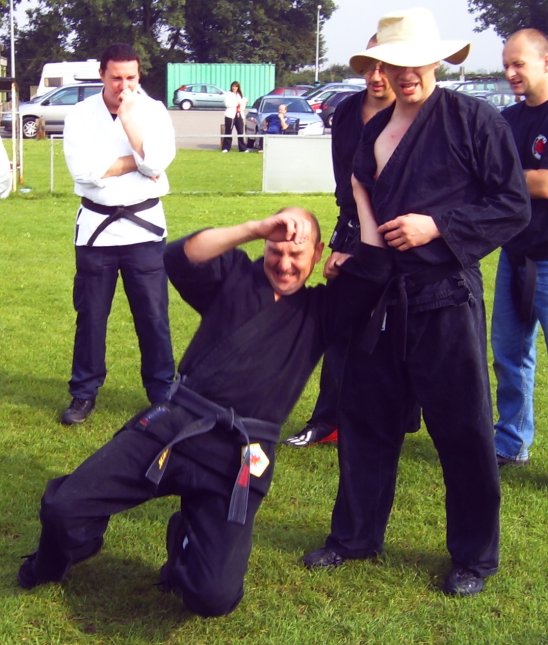
Getting his own back on Mike Sanderson (and wearing a stylish hat)
|
There are no styles
Following on from the above point, I believe we shouldn't think in terms of different styles of Karate. Training in Karate is an individual journey, so ultimately each practitioner should have their own Karate. That's not to say that you can do anything you want and call it Karate. But as long-term students progress they will naturally develop their own way of working that reflects their physique, previous injuries, age and even temperament. This is as it should be. In modern styles however individual interpretation is often stifled, with students being encouraged to all practice exactly the same techniques in the same way. I believe this is a modern phenomena. In the past there was Matsumura's Karate, Itosu's Karate and so on. But as Karate spread, first to the Okinawan schools, then to Japan it became more codified and regimented. From there the development of fixed styles was virtually inevitable.
So what is Shinseido if not a style? Our aim isn't to produce clones of the chief instructor. Rather we aim to help each student develop to their full potential. We work from common principles, with the kata as a common frame of reference, but each student will eventually develop their own interpretation of those principles. So Shinseido can be thought of as an organisational structure and a set of principles, rather than a style as such.